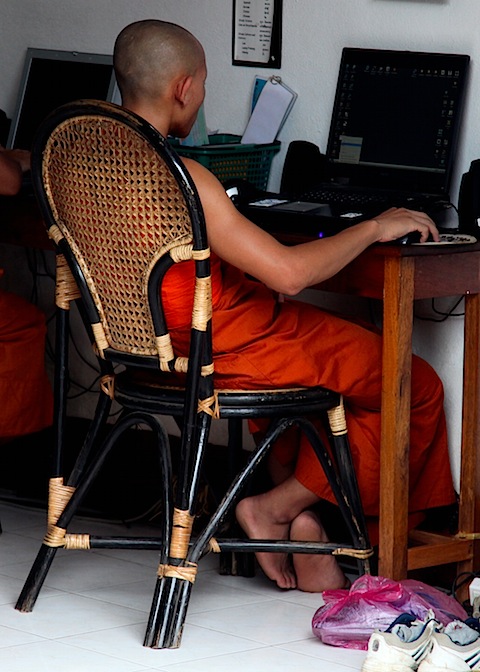Laos. Wen and I had wanted to go for ages as we'd heard nothing but great things about it. Now we've been. Read on.
- Our plane has touched down and is slowly taxiing to the gate. The pilot won't be rushed as this is Laos and the next incoming flight is at least an hour away. And the gate is really just a parking stall where you walk to the terminal.
The other reason he's going slow is someone probably needs time to wake everyone in the airport up. I can picture a harried air traffic controller who has been rudely jerked from sleep by the expected arrival of our plane and is now scurrying down to a boiler room and turning a massive crank to wind up the airport experience.
In Ottawa, the airport greets you with ads for high tech and defense companies. In New York, banks and software companies vie for your attention the moment you deplane.
In Vientiane - the capital of Laos - the first ad you see is for the local beer. The second ad is also for said beer. The third ad is for a cellphone company. And then you're in customs, where, if you're a Canadian it bafflingly costs $7 more to get a visa than for any other country's citizens.
The whole visa process, which, with its four person, three step process that seems geared more towards full employment than border security, is a gentle introduction to the fact that Laos is a technically communist but really just autocratic state.
Don't let the "Democratic" in "Laos Popular Democratic Republic" fool you. There's one party. Above it is a politburo that reserve the right to issue binding decrees and it's headed by a brigadier general (some customs officers grimly wear pins with his image).
This explains some of the subtle differences you'll find in Laos versus almost every other country in the world. For example, there's immigration control on domestic flights and the streets are routinely cleared for police-escorted motorcades of 30-something bureaucrats.
- We immediately flew to Luang Prabang. We bought our ticket in the airport and it included an escorted walk from the international terminal to the open-air concrete bunker that masquerades as the domestic terminal.
The flight to Luang Prabang reminds you that Laos is the poor child of Southeast Asia. Shortly after takeoff you notice that there are almost no paved roads on the outskirts of Vientiane, save the 'highways'.
As you pass over Laos' beautiful mountains, you'll see countless notches cut in the landscape. 80% of the population is subsistence farmers and they routinely burn the rainforest to clear fields. With a rapidly growing population (up by 1/3 to 6.2 million in the past 15 years), their grandkids are not going to be able to live this way.

After a couple of stomach churning and neck bending turns (I think Mas Wings pilots train in Laos) you're on the ground and in arguably the prettiest city in Southeast Asia.
Luang Prabang sits at the intersection of the Mekong an Nam Khan rivers. Historically it was the capital of one of the three Lao kingdoms. In the 19th century the French forcefully united them and added the 's' to the country's name. (Despite what my sixth grade geography teacher insisted, it's pronounced 'l-ow', not 'lay-os'.)
Since it was a capital, there's an old royal palace. It contains a litany of old buddhas, royal detritus and gifts from foreign dignitaries. Their Asian neighbours gave carvings and silver goods; the U.S. gave pens, radios and a scale replica of the Apollo Lander.
There are no photos allowed because it is a royal palace and no mere layman can photograph royal goods. This rule extends to the royal cars.
In their garage, a set of aging Lincoln Continentals and even an Edsel and a rotting Citroën sit stoically awaiting royal return. The mere act of painting them white and having the king ride in them has turned them into treasures that can only be captured by official cameramen.
The odd thing about all of this show of respect to the royal family is that they ultimately got no respect from their countrymen. The war in Vietnam spilled into Laos (the Ho Chi Minh trail was mostly in Laos) with America dropping more bombs on Laos than were dropped in all of World War II (there are over 8 million unexploded bombs in the country-more than one per person) and fomenting a good old civil war.
The royal family was split in the civil war bit ultimately they all lost and the communists won. The king died in captivity and there hasn't been a royal family since the 1970.
You wouldn't know this from the fealty shown to the king at the palace. You also wouldn't know it because there's not a single sign anywhere in the museum that explains the history of the country. Nor can you ever get a Laotian to explain their country's history. They just smile and say something like "as you know, Laos has a complex history."
Besides the royal palace, Luang Prabang has a lot of Buddhist temples. 34 in fact, and that, combined with the colonial buildings built by the French earned the city a UNESCO world heritage designation in 1995. Perhaps unsurprisingly, that's also the year they paves the main road in the city and tourism took off.

Luang Prabang is a reverse Potemkin village; it has a population of 200,000 but everything a tourist wants to see is found on a narrow isthmus of land between between the junction of the two rivers and around nearby Phousy Hill. The fact that almost no one lives on the far side of the Mekong or Nam Khan rivers and no buildings are above three stories reinforces this sensation.
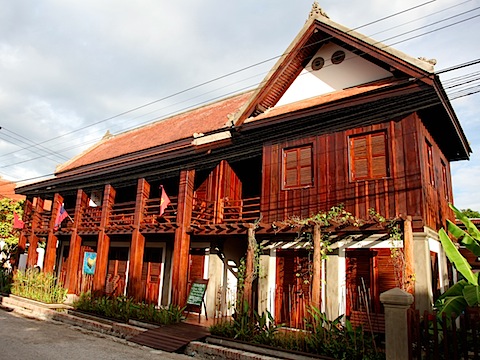
This means that you can take in many of the temples, the royal palace (and the baffling carvings from local stories that are found in an adjoining temple), walk all the main streets, take a boat across the Mekong and still easily make it up the hill to watch the sunset.
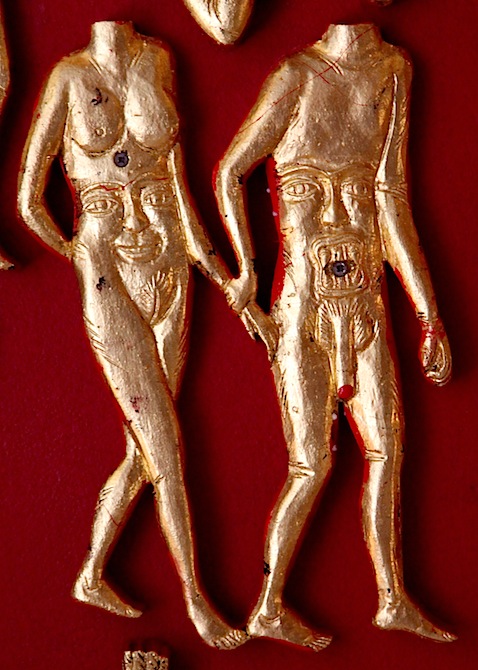
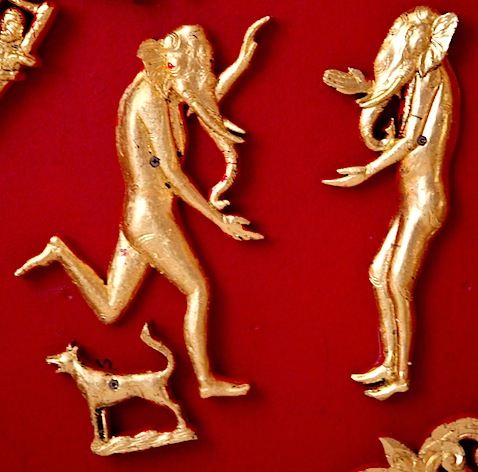

- So what else to do? Besides sitting in the cafes and sipping coffee (Joma and Ancient Hotel are recommended) or taking a cooking class, you could go hiking or ride elephants.
You can actually do both courtesy of one man, Markus. He is a character who has transformed tourism in the area.
In 1998 he quit a going nowhere government job in Germany and moved to Luang Prabang to open a restaurant. In 2001, unsatisfied with what was offered, he opened Tiger Trail to provide tours (hiking, biking, etc.) that would highlight and preserve the local culture. This was followed a few years later by the Lao Spirit resort (a beautiful place 35km up the Nam Khan; the bungalows have some of the best views ever).
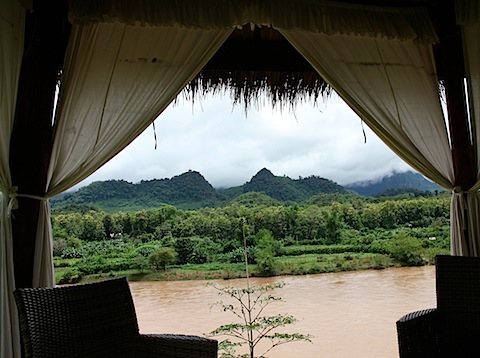
Then in 2008 he sold most of his shares and bought an elephant preserve where he saves elephants from the logging industry.
It was at this preserve that Wendy finally conquered a pachyderm. We got to ride them (both on a howda and on their necks). We practiced our mahout calls (seung seung to bend on one knee and get on; pie for forward) and fed them and bathed them. We also learned that you should always approach an elephant from its right; some are trained to attack on the left and they can be unpredictable if you walk behind them.
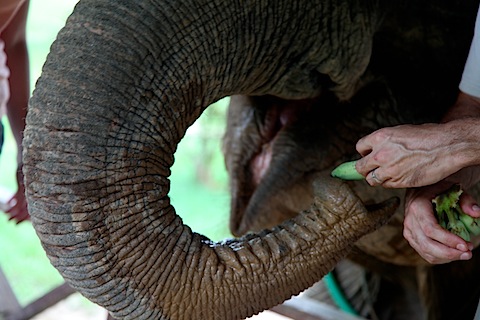

We also learned that Laos uses to called the land of a million elephants. Given that Laos is only two million square kilometers and elephants consume 200-250 kg per day in food, this was more likely hyperbole than fact.
We also learned that the first rule of being a mahout is to never trust an elephant. This was revealed several times when our elephants (more frequently Wendy's) would suddenly stop, lumber off to the side of the river or track and eat despite all the efforts of the mahouts.

On a different day we did a seven hour hike up through the mountains that are opposite the elephant camp across the Nam Khan. Despite hiking in near continuous rain (it turns out August is the rainiest month in Luang Prabang) this was one of the best hikes I have ever done.
It started in low-lying rice paddies, climbed through banana and jungle-covered limestone hills into Hmong villages and mountain pastures.


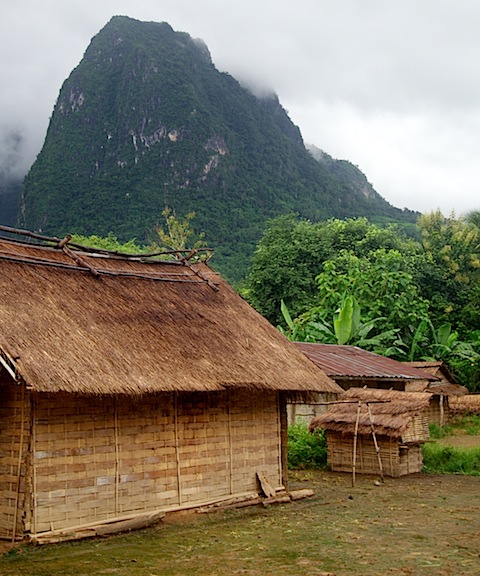
And finally it descended down to the other great thing to see in Luang Prabang-waterfalls.
- I don't know what you think waterfalls in paradise look like, but for me they're near identical to the Tad Sae and Kuang Si falls near Luang Prabang.
The Tad Sae is approached from the river, where it spills forth from many places in the banks. As you climb alongside it, you encounter numerous swimming pools and possibly the occasional bathing monk.
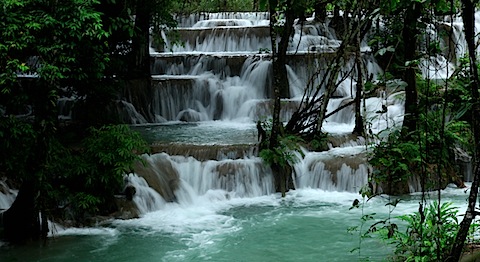

The Kuang Si falls are substantially further from town and best approached by scooter. The voyage takes you along the Mekong, through villages of jeering children and is only occasionally interrupted by confused chickens or water buffalo. There is mercifully little traffic as the road ends at the falls.
The falls start out as a bear preserve that leads to a series of miniature falls and pools. You can swim here despite it being the rainy season however the current is so strong that you can't swim against it. it is extremely depressing to try and swim somewhere and end up further back from where you started - particularly when if you go too far back you go over a waterfall.
In North America this would be the perfect drowning machine; judging from the lack of bathers, the Lao seem to have a preternatural understanding of what 'swim at your own risk' means.

At the top of the last pool you come to the main falls which explode out of the jungle in a furious torrent of water. In fact there's so much water that it cascades downwards everywhere. No rock is too small to become a sluice and water tumbles from all directions. It is sublime.

5
After a week in Luang Prabang we took the let's-call-it-eight-but-everyone-knows-it's-at-least-ten-hours bus ride to Vientiane. It's only 400 kilometers but since you're winding along mountain roads it takes forever (those mountains only end maybe sixty kilometers from Vientiane). Fortunately, the scenery is spectacular and, if you spent the extra $2, you're riding in the "king of bus".
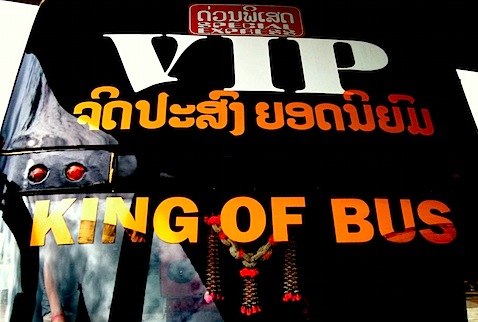
I can't emphasize how beautiful Laos is. I'm definitely going to go back one day and hike around Ban Bangkalo and Ban Lakha in Kasi district. Jungle-covered limestone mountains plunge into forest and fields; farmers' paths crisscross everything.
- The bus ride gives you time (lots of time) to reflect on how undeveloped Laos is. On the entire journey I saw one factory: a cement manufacturer.
As you traverse the country you see the goods of the same ten Western brands. There is not one chain store in the entire country - although some local bakeries, coffee shops and convenience stores are creating their own chains.
The people here are incredibly friendly (perhaps the civil war killed their desire to fight) but the flip side is there's absolutely no sense of urgency on the part of anyone. The whole country trundles along at the pace of a small town while it's neighbours battle for 21st century economic supremacy.
This isn't a criticism, but a comment. And in fact, Laos might be destined (okay, maybe just handicapped) by it's geography to play this role.
In addition, the quality of the Laos government's fiscal and monetary policy is open for debate. There are signs that the country has gone through some mean inflation.
The smallest bill is 500 Kip (a great name for a currency) but you will almost never see anything priced in multiples less than 1,000.
In one shop we saw the following homage to their first sale in 1998-note the 1 Kip note.

Similarly, in one temple we saw 20 and 50 Kip notes folded into icons:
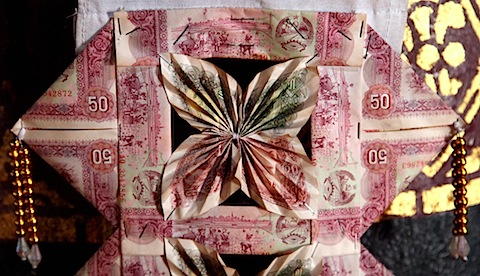
- You may be noticing that everything I've mentioned is about either Laos or Luang Prabang. I've said almost nothing about Vientiane.
And that's on purpose. There's not much to see in the city. There are a smattering of various petty bureaucracies and a few concrete temples. Nothing to write home about - and the Lao even acknowledge it themselves.
The main boulevard outside the Presidential Palace leads to a concrete gate built in the 1960s:

Here's the description attached to it:

But all is not for nought. It's a nice place to while away a day or two in cages as you prepare for your next adventure. It also has fantastic sunsets along the Mekong. This is big sky country:
- There's one other very interesting facet to Vientiane - the people. Not the locals (great people, but you've already met them up north), but a curious mercenary capitalist class.
The city is full of 40- or 50-something white guys who are slightly overweight, have a lean, ex-military look with short cropped hair and they frequently carry laptops.
They give the impression of being in Laos as it is the place where some obscure form of earth needs moving: a fiber optic cable needs to be laid; a satellite uplink station needs to be built or a series of microwave towers are going up. These guys feel like hired guns who honed their skills building out Europe and America and their swan song is now calling from Asia.
- Reading the above, you might get the impression that I'm negative on Laos or think that it is backwards. Nothing could be further from the truth.
It's a beautiful country with unbelievably friendly people who are finding their own path in a complex world (and carrying some very complex cultural baggage). This is a also country where few people have any money but cellphones abound, you find satellite dishes in remote thatched communities and the locals have a nicer (and substantially cheaper) international bus service than most other nations.

- I have no hard data to back this up, but I suspect that one of the challenges Laos is going to face is that when your country moves away from agriculture, you just can't get drunk all the time.
There are several hints that the Lao are perpetually getting wasted. When we took our cooking class the manual emphasized how important it is for the locals to drink whiskey with each other (ah, culture).
We asked our guide on our rainy hike where all the people were in the villages: he told us they drink whiskey when it rains.
And when we went to one of the waterfalls, a bunch of locals were having a picnic. Several Johnny Walker bottles littered their table.
I should mention that the local whisky (Lao Lao) is also filthy booze. I had a glass at one restaurant and it burned so badly that I poured it into a neighbouring planter. A mere whiff of this faux rubbing alcohol is sufficient to induce nausea.
- As mentioned in an earlier entry, Lao food is great.
We had a few additional great dishes. Fried bamboo with pork:

The Tamarind restaurant in Luang Prabang is incredible. Here you see their Ping Som Moo. It's cured pork placed on a bed of garlic, then wrapped in garlic and barbecued in a bamboo skewer.
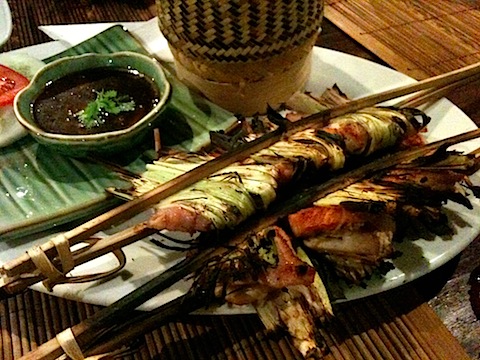
They also have an appetizer that lets you taste an assortment of local salsas and dips. You're looking at jeow bong, jeow mak len (mild tomato salsa), jeow mak keua (smoky eggplant dip) and jeow pak hom (mildly spiced blend of coriander and garlic). It comes with khai pene: Mekong seaweed pounded into sheets and sundried with tomatoes, garlic and sesame
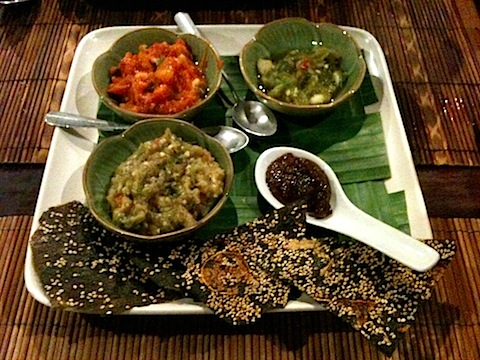
A few other recommended places to eat in Luang Prabang: The Blue Lagoon (thanks Colleen & Tom for the recommendation!) and Dyen Sabai (across the Nam Khan; they've their own free boat).
- A few random observations:
A)
Laotian has the same script as Thai. The Lao get Thai television and read it's subtitled foreign movies plus listen to their tv shows. The result is that all Lao can speak/read Thai but not vice versa. Our hotel receptionist couldn't explain why, rather she chalked it up to "same same but different".
Incidentally, despite having a relatively lovely language, the Lao all answer their phone "hello" (versus sabai dee). It looks like this is one more culture that wont be adopting Bell's desired "ahoy, ahoy".
B)
While in Laos and Vietnam I was reading Philip Caputo's A Rumor of War and John Sack's M . Both talk about the omnipresent red dust that covers Vietnam and turns to sticky mud during the rainy season.
It also exists in Laos. I went for a run one night and found myself covered in a thin reddish film. And don't even get me started on what it's like to hike here when it rains:

C)
When we arrived in Luang Prabang we took a cab to our guest house. The airport taxi authority decided that we'd share the cab with another couple even though we were going to different hotels.
As we talked to them I felt like I was talking to my doppelgänger; it could have been me if I'd made a few different decisions.
In order to understand this, some background on me. I used to be a consultant but didn't like it so did something else and eventually wound up at business school and then lived in New York. The Internet has also made me OCD: whenever I want to know something I instantly look it up (unless dining).
So imagine how I felt when we got in the taxi and it turned out that the other couple - who are a similar age to us - are also from New York. We asked them how long they'd lived there and it turned out to be many years except for "a few years in Boston". This is alumni jargon used by Harvard Business School grads to test whether their audience might be receptive to their unique schooling.
I then asked if either of them happened to know the population of Laos. She turned to him and said "I'll bet you hate not having the Internet here to look this up." A shiver ran up my spine.
And then she said "pretend it's a case or an interview problem". Only consultants would ask someone a silly question like "how many people are there in Laos" as part of a job interview; calling your work a "case" is to a trick to make it sound more important than it is.
At that moment I realized that this guy was me in an alternate reality (preppy American Lindsay?) and I had to flee the car before the world collapsed in on itself.
D)
One of the odd legacies of the French is that the Laos play petanque. You will literally be driving through the countryside and stumble upon a group of men playing the game on the roadside. Perhaps it's because the game is so suited to the Lao pace of life.
E)
One night in Luang Prabang we were walking along the Mekong when the power went out. The city went black and then the massive, swift river began to glow with the night. Previously invisible against the town's lights, it was now the only source of illumination. Then the power flipped back on and the moment was irretrievably lost.
F)
One final comment on monks. They abound in Laos and you see them everywhere. If you're lucky, you'll hear them drumming to the moon cycles:
Monks drumming in Luang Prabang
Almost all of them are young boys.
It's not that the prepubescent male Lao are remarkably pious, rather it's about education. There are school fees in Laos (I don't think the tax collection is good enough for the government to provide it as a full service; this is a country where places give their street address as "near the post office") and if you can't afford them you send your kid to a monastery to receive an education. When they're old enough, they typically drop out of the monastery and get a job - with more skills than they would have otherwise picked up.
